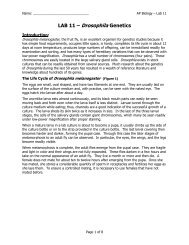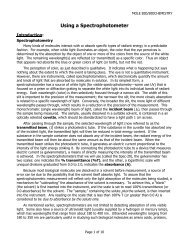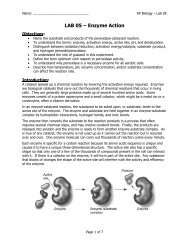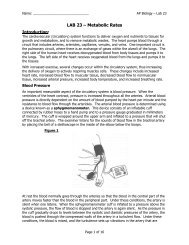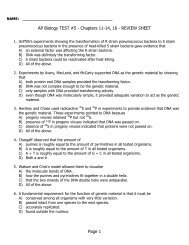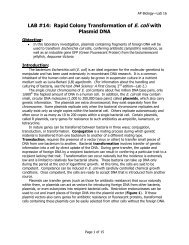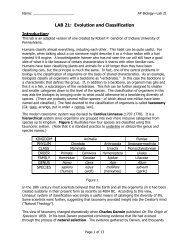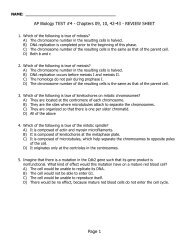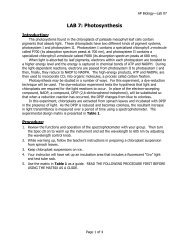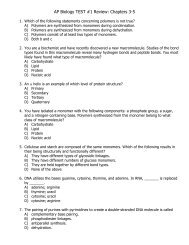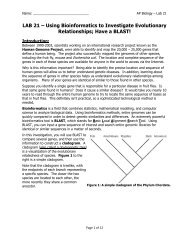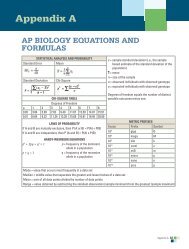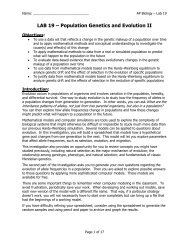Crime Scene Investigator PCR Basics⢠Kit
Crime Scene Investigator PCR Basics⢠Kit
Crime Scene Investigator PCR Basics⢠Kit
Create successful ePaper yourself
Turn your PDF publications into a flip-book with our unique Google optimized e-Paper software.
Lesson 1 <strong>PCR</strong> Amplification<br />
<strong>PCR</strong> amplification is DNA replication in a test tube. The portion of the DNA you want to<br />
make copies of is called the target sequence. The sample of DNA obtained at a crime<br />
scene and the suspect's DNA samples contain the target sequence.<br />
<strong>PCR</strong> relies on three principles of molecular biology<br />
1. Denaturation - melting double stranded DNA template into single stands<br />
2. Annealing - complementary DNA strand hybridization via DNA primers<br />
3. Extension - DNA strand synthesis via DNA polymerase<br />
Denaturation. Before new DNA synthesis can begin the double stranded DNA template<br />
must be unwound and separated into single strands. In cells this is carried out by a family<br />
of enzymes. In <strong>PCR</strong>, heat is used to melt apart – or denature – the double stranded DNA<br />
template.<br />
Annealing. Before a target region of DNA can be amplified, one must determine short<br />
sequences of DNA upstream (at the 5' end) and downstream (at the 3' end) of the target<br />
loci region of interest. These areas are then used to make short pieces of DNA, called<br />
primers or oligonucleotides, which are complementary to regions upstream and downstream<br />
of the target loci region (Figure 11). Primers serve as start and stop points for amplifying<br />
the target region of the DNA to be copied.<br />
Fig. 11. Primers annealed to a target DNA sequence during <strong>PCR</strong>.<br />
In <strong>PCR</strong>, complementary strand hybridization takes place when oligonucleotide primers<br />
anneal, or bind, to their respective complementary base pair sequences on the template.<br />
Hybridization is the process that describes the binding of the oligonucleotide primer to the<br />
template DNA. The two strands anneal to each other, forming a 'hybrid'. Like bookends, the<br />
two primers are designed and synthesized in the laboratory with a specific sequence of<br />
nucleotides so they will anneal at the opposite ends and on the opposite strands bracketing<br />
the target stretch of double-stranded DNA (template strand) to be amplified. Therefore, the<br />
target sequence is determined by the location that the primers anneal to.<br />
Extension. Primers are needed because the DNA polymerase requires an already<br />
existing nucleotide chain to bind and add nucleotides to one at a time. Once the<br />
polymerase locates and binds to template DNA and the primer, it initiates the addition of<br />
nucleotides and synthesizes new copies of the double stranded template DNA by adding<br />
nucleotides onto the primer and extending it. Therefore, primers provide a starting point for<br />
the DNA polymerase.<br />
These 3 steps – denaturation, annealing, and extension together make up one <strong>PCR</strong><br />
cycle. A complete <strong>PCR</strong> reaction involves many repetitious of a single <strong>PCR</strong> cycle. In this<br />
experiment, your <strong>PCR</strong> reactions will cycle 35 times.<br />
35




